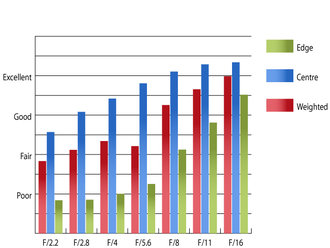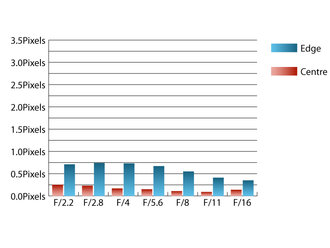Lomography x Zenit 85mm f/2.2 Petzval Art Lens Review
Lomography Petzval 85mm f/2.2 Art Lens Performance
As far as sharpness is concerned, this lens isn't aimed at those after pin-sharp images, and it performs as such. The lens is deliberately designed to have a noticeable amount of field curvature, so the lens should yield a sharp image in the centre with a fuzzy vignette around the edges. The new Petzval kind of achieves this, although sharpness in the centre of the frame can only be considered fairly good in the centre at f/2.2, rising to good levels at f/2.8 and excellent levels at f/8. Unfortunately, at f/8 much of this lens' effect is diminished and images look more like they were taken with a kit lens zoom from the 1980s, rather than a re-manufactured classic. Even so, if sharpness isn't a high priority, you may still enjoy getting the most out of the effect produced. To really see the effect, backgrounds with lots of regular detail are required, such as patterned wallpaper, or light shining through tree branches. Without this, images lack the swirly look the Petzval lens design is known for, which limits its overall usefulness.  MTF @ 85mm | How to read our chartsThe blue column represents readings from the centre of the picture frame at the various apertures and the green is from the edges. Averaging them out gives the red weighted column.The scale on the left side is an indication of actual image resolution. The taller the column, the better the lens performance. Simple. For this review, the lens was tested on a Nikon D600 using Imatest. |
Chromatic aberrations are well controlled, remaining below 0.75 pixel widths. This low level of fringing will be difficult to spot, even in harsh crops, or large prints.
 CA @ 85mm | How to read our chartsChromatic aberration is the lens' inability to focus on the sensor or film all colours of visible light at the same point. Severe chromatic aberration gives a noticeable fringing or a halo effect around sharp edges within the picture. It can be cured in software.Apochromatic lenses have special lens elements (aspheric, extra-low dispersion etc) to minimize the problem, hence they usually cost more. For this review, the lens was tested on a Nikon D600 using Imatest. |
Falloff of illumination is quite pronounced, which may actually enhance the vignette effect produced by this lens. At f/2.2 the corners of the frame are 2.69 stops darker than the image centre and visually uniform illumination is achieved with the aperture stopped down to f/5.6 or beyond.
Distortion is well controlled. Imatest was only able to detect 0.815% pincushion distortion, which is quite a low level and should not require correction in most cases.
Although this lens appears to have some kind of anti-reflective coating applied to lens surfaces, it is very prone to flare, and contrast suffers greatly when shooting into the light. This may be forgiven with this lens being sold as a special effect optic, but even so, it is still something to be aware of.
Add your message
Login required
Please login here or if you've not registered, you can register here. Registering is safe, quick and free.
Please login here or if you've not registered, you can register here. Registering is safe, quick and free.
photodo Stats
1102 lenses
428 MTF tests
74 in-depth photodo reviews
100+ users join each day
Help the lens community by reviewing or rating a lens today via our lens search
428 MTF tests
74 in-depth photodo reviews
100+ users join each day
Help the lens community by reviewing or rating a lens today via our lens search
Latest Lens Reviews
- Chinon 28mm f/2.8 Vintage Lens Review
- Canon EF 70-200mm f/4L IS II USM Lens Review
- Samyang AF 85mm f/1.4 EF Review
- Sigma 70mm f/2.8 DG Macro Art Review
- Samyang AF 24mm f/2.8 FE Review
- Meike 50mm f/1.7 Review
- Tamron 70-210mm f/4 Di VC USD Review
- Lensbaby Burnside 35mm f/2.8 Review
- Asahi Super Takumar 50mm f/1.4 Review
- Asahi Super-Multi-Coated Takumar 135mm f/3.5 Review
